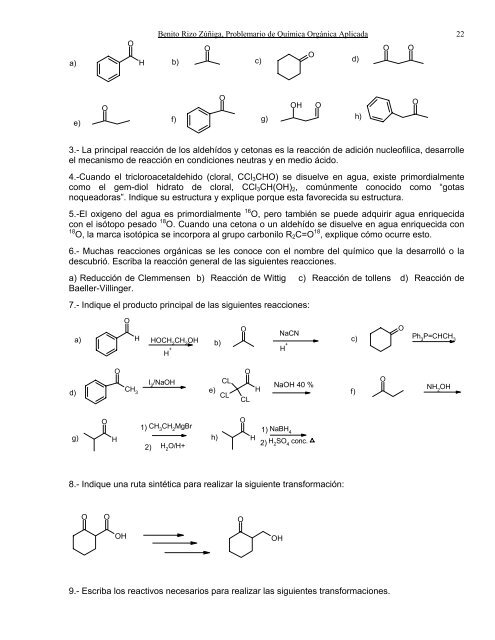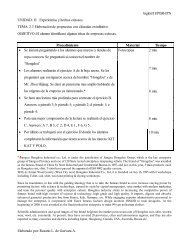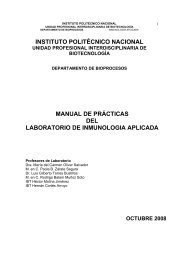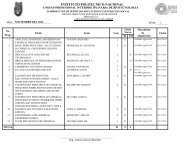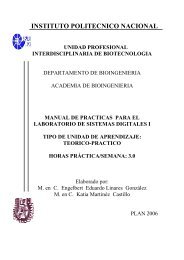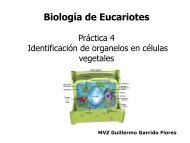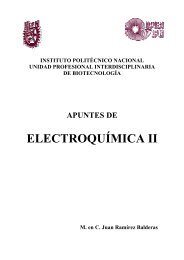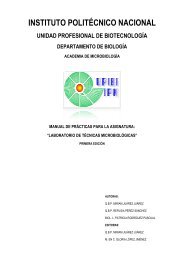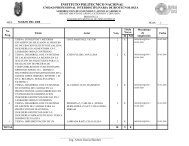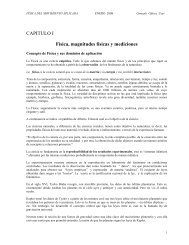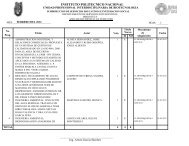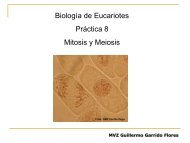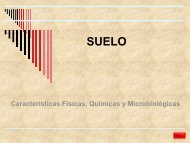Problemario de Química Orgánica Aplicada - biblioteca upibi ...
Problemario de Química Orgánica Aplicada - biblioteca upibi ...
Problemario de Química Orgánica Aplicada - biblioteca upibi ...
You also want an ePaper? Increase the reach of your titles
YUMPU automatically turns print PDFs into web optimized ePapers that Google loves.
Benito Rizo Zúñiga, <strong>Problemario</strong> <strong>de</strong> <strong>Química</strong> <strong>Orgánica</strong> <strong>Aplicada</strong> 22<br />
a)<br />
O<br />
H b)<br />
O<br />
c)<br />
O<br />
d)<br />
O O<br />
e)<br />
O<br />
O<br />
OH<br />
f) g) h)<br />
3.- La principal reacción <strong>de</strong> los al<strong>de</strong>hídos y cetonas es la reacción <strong>de</strong> adición nucleofilica, <strong>de</strong>sarrolle<br />
el mecanismo <strong>de</strong> reacción en condiciones neutras y en medio ácido.<br />
4.-Cuando el tricloroacetal<strong>de</strong>hido (cloral, CCl3CHO) se disuelve en agua, existe primordialmente<br />
como el gem-diol hidrato <strong>de</strong> cloral, CCl3CH(OH)2, comúnmente conocido como “gotas<br />
noqueadoras”. Indique su estructura y explique porque esta favorecida su estructura.<br />
5.-El oxigeno <strong>de</strong>l agua es primordialmente 16 O, pero también se pue<strong>de</strong> adquirir agua enriquecida<br />
con el isótopo pesado 18 O. Cuando una cetona o un al<strong>de</strong>hído se disuelve en agua enriquecida con<br />
18 O, la marca isotópica se incorpora al grupo carbonilo R2C=O 18 , explique cómo ocurre esto.<br />
6.- Muchas reacciones orgánicas se les conoce con el nombre <strong>de</strong>l químico que la <strong>de</strong>sarrolló o la<br />
<strong>de</strong>scubrió. Escriba la reacción general <strong>de</strong> las siguientes reacciones.<br />
a) Reducción <strong>de</strong> Clemmensen b) Reacción <strong>de</strong> Wittig c) Reacción <strong>de</strong> tollens d) Reacción <strong>de</strong><br />
Baeller-Villinger.<br />
7.- Indique el producto principal <strong>de</strong> las siguientes reacciones:<br />
d)<br />
O<br />
a) H HOCH2CH2OH b)<br />
g)<br />
O<br />
O<br />
H<br />
CH 3<br />
H +<br />
I 2 /NaOH<br />
1) CH3CH2MgBr 2)<br />
H 2 O/H+<br />
e)<br />
CL<br />
CL<br />
O<br />
O<br />
CL<br />
O<br />
H<br />
H<br />
NaCN<br />
H +<br />
NaOH 40 %<br />
NaBH 4<br />
2) H2SO4 conc.<br />
8.- Indique una ruta sintética para realizar la siguiente transformación:<br />
O<br />
O O<br />
OH<br />
h)<br />
9.- Escriba los reactivos necesarios para realizar las siguientes transformaciones.<br />
1)<br />
OH<br />
O<br />
c)<br />
f)<br />
O<br />
O<br />
O<br />
Ph 3 P=CHCH 3<br />
NH 2 OH


